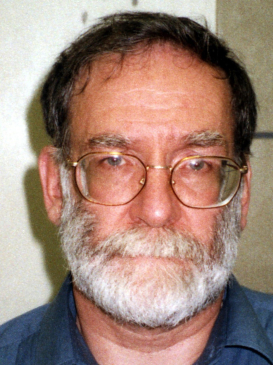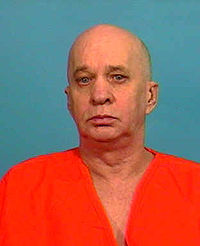On 31 January 2000, a jury found Shipman guilty of 15 murders. He was sentenced to life imprisonment and the judge recommended that he never be released.
After his trial, the Shipman Inquiry, chaired by Dame Janet Smith, investigated all deaths certified by Shipman. About 80% of his victims were women. His youngest victim was Peter Lewis, a 41-year-old man. Much of Britain's legal structure concerning health care and medicine was reviewed and modified as a direct and indirect result of Shipman's crimes, especially after the findings of the Shipman Inquiry, which began on 1 September 2000 and lasted almost two years. Shipman is the only British doctor found guilty of murdering his patients.
Shipman died on 13 January 2004, after hanging himself in his cell at Wakefield Prison in West Yorkshire.
Early life and career
Harold Frederick Shipman was born in Nottingham, England, the second of four children of Vera and Harold Shipman, a lorry driver. His working class parents were devout Methodists. Shipman was particularly close to his mother, who died of cancer when he was 17. Her death came in a manner similar to what later became Shipman's own modus operandi: in the later stages of her disease, she had morphine administered at home by a doctor. Shipman witnessed his mother's pain subside in light of her terminal condition, up until her death on 21 June 1963.Shipman continued working as a GP in Hyde throughout the 1980s and founded his own surgery on Market Street in 1993, becoming a respected member of the community. In 1983, he was interviewed on the Granada television documentary World in Action on how the mentally ill should be treated in the community.
Detection
In March 1998, Dr Linda Reynolds of the Brooke Surgery in Hyde, prompted by Deborah Massey from Frank Massey and Son's funeral parlour, expressed concerns to John Pollard, the coroner for the South Manchester District, about the high death rate among Shipman's patients. In particular, she was concerned about the large number of cremation forms for elderly women that he had needed countersigned. The matter was brought to the attention of the police, who were unable to find sufficient evidence to bring charges; The Shipman Inquiry later blamed the police for assigning inexperienced officers to the case. Between 17 April 1998, when the police abandoned the investigation, and Shipman's eventual arrest, he killed three more people. His last victim was Kathleen Grundy, a former Lady Mayor of Hyde, who was found dead at her home on 24 June 1998. Shipman was the last person to see her alive, and later signed her death certificate, recording "old age" as cause of death.Grundy's daughter, lawyer Angela Woodruff, became concerned when solicitor Brian Burgess informed her that a will had been made, apparently by her mother (although there were doubts about its authenticity). The will excluded her and her children, but left £386,000 to Shipman. Burgess told Woodruff to report it, and went to the police, who began an investigation. Grundy's body was exhumed, and when examined found to contain traces of diamorphine (heroin), often used for pain control in terminal cancer patients. Shipman was arrested on 7 September 1998, and was found to own a typewriter of the type used to make the forged will.Prescription For Murder, a book by journalists Brian Whittle and Jean Ritchie, reports two theories on why Shipman forged the will. One is that he wanted to be caught because his life was out of control; the other reason, that he planned to retire at fifty-five and leave the country.
Trial and imprisonment
Shipman's trial, presided over by Mr Justice Forbes, began on 5 October 1999. Shipman was charged with the murders of Marie West, Irene Turner, Lizzie Adams, Jean Lilley, Ivy Lomas, Muriel Grimshaw, Marie Quinn, Kathleen Wagstaff, Bianka Pomfret, Norah Nuttall, Pamela Hillier, Maureen Ward, Winifred Mellor, Joan Melia and Kathleen Grundy, all of whom had died between 1995 and 1998.On 31 January 2000, after six days of deliberation, the jury found Shipman guilty of killing 15 patients by lethal injections of diamorphine, and forging the will of Kathleen Grundy. The trial judge sentenced him to 15 consecutive life sentences and recommended that he never be released. Shipman also received four years for forging the will. Two years later, Home Secretary David Blunkett confirmed the judge's whole life tariff, just months before British government ministers lost their power to set minimum terms for prisoners.
On 11 February 2000, ten days after his conviction, the General Medical Council formally struck Shipman off its register.
Shipman consistently denied his guilt, disputing the scientific evidence against him. He never made any statements about his actions. His defence tried, but failed, to have the count of murder of Mrs Grundy, where a clear motive was alleged, tried separately from the others, where no obvious motive was apparent. His wife, Primrose, apparently was in denial about his crimes as well.
Although many other cases could have been brought to court, the authorities concluded it would be hard to have a fair trial, in view of the enormous publicity surrounding the original trial. Also, given the sentences from the first trial, a further trial was unnecessary. The Shipman Inquiry concluded Shipman was probably responsible for about 250 deaths. The Shipman Inquiry also suggested that he liked to use drugs recreationally.
Despite the prosecutions of Dr John Bodkin Adams in 1957, Dr Leonard Arthur in 1981, and Dr Thomas Lodwig in 1990 (amongst others), Shipman is the only doctor in British legal history to be found guilty of killing patients. According to historian Pamela Cullen, Adams had also been a serial killer—potentially killing up to 165 of his patients between 1946 and 1956—and it is estimated he may have killed over 450, but as he "was found not guilty, there was no impetus to examine the flaws in the system until the Shipman case. Had these issues been addressed earlier, it might have been more difficult for Shipman to commit his crimes." H. G. Kinnell, writing in the British Medical Journal, also speculates that Adams "possibly provided the role model for Shipman".
Death
Harold Shipman committed suicide by hanging in his cell at Wakefield Prison at 06:20 on 13 January 2004, on the eve of his 58th birthday, and was pronounced dead at 08:10. A Prison Service statement indicated that Shipman had hanged himself from the window bars of his cell using bed sheets. Some British tabloids expressed joy at his suicide and encouraged other serial killers to follow his example; The Sun ran a celebratory front page headline, "Ship Ship hooray!"Some of the victims' families said they felt cheated, as his suicide meant they would never have the satisfaction of Shipman's confession, and answers as to why he committed his crimes. The Home Secretary David Blunkett noted that celebration was tempting, saying: "You wake up and you receive a call telling you Shipman has topped himself and you think, is it too early to open a bottle? And then you discover that everybody's very upset that he's done it."
Despite The Sun's celebration of Shipman's suicide, his death divided national newspapers, with the Daily Mirror branding him a "cold coward" and condemning the Prison Service for allowing his suicide to happen. The Independent, on the other hand, called for the inquiry into Shipman's suicide to look more widely at the state of Britain's prisons as well as the welfare of inmates. In The Guardian, an article by Sir David Ramsbotham (former Chief Inspector of Prisons) suggested that whole life sentencing be replaced by indefinite sentencing as these would at least give prisoners the hope of eventual release and reduce the risk of their committing suicide as well as making their management easier for prison officials.
Shipman's motive for suicide was never established, although he had reportedly told his probation officer that he was considering suicide so that his widow could receive a National Health Service (NHS) pension and lump sum, even though he had been stripped of his own pension. His wife received a full NHS pension, which she would not have been entitled to if he had died after the age of 60. FBI profiler John Douglas asserted that serial killers are usually obsessed with manipulation and control, and killing themselves in police custody, or committing "suicide by cop", can be a final act of control. Shipman had been encouraged to take part in courses which would have had him confess his guilt. After refusing, he became emotional and close to tears when privileges - including the opportunity to telephone his wife - were removed. Privileges had been returned the week before the suicide. Additionally, Primrose, who had consistently believed that Shipman was innocent, might have begun to suspect his guilt. According to Shipman's ex-cellmate Tony Fleming, Primrose recently wrote her husband a letter, exhorting him to "tell me everything, no matter what".





